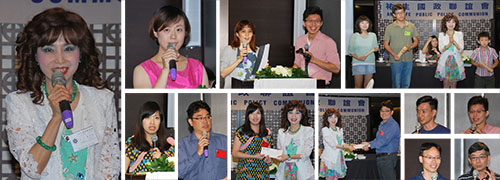Sketch of Public Policy Communion, August 2015Date: 2015-09-12
Section: Activity | 
本會已於2015年8月16日假晶華酒店地下三樓晶英舉行「祐生國政聯誼會」。在主持人黃晉英秘書長宣布後揭開當日活動序幕,在輕鬆、活潑的節目過後,隨即由主持人帶來重要訊息:「最近夏日對流旺盛,各地遭受暴雨的侵襲,造成外出的風險提高,使得人們心理層面不安,進而影響政治經濟的變化。在這種意外頻傳的情況下,請各位務必要注意自身的安全。另外,在持續的高溫下容易產生疫病,接踵而來的即是饑荒及戰爭等災變,因此,我們應多關注世界的變化,以為警惕。最後,生活在資訊氾濫的網路世代,提醒大家能有智慧地做出判斷,擷取正確的資訊。祐生透過數位化,期望讓每位成員都能有全方位的知識,帶領更多人往對的方向前進。」
The August Archilife Public Policy Communion of 2015 was held on August 16, 2015. After a series of relaxing and fun activities, Secretary General Huang Chin-ying made the following announcement, "Rapid airflow in the summer has brought violent rain and storms worldwide. The risk of outdoor activities has risen and people are becoming rather uneasy. The brewing sense of insecurity is now affecting political and economic policies worldwide. Accidents have been reported, so please pay attention to your own safety. In addition, sustained high temperatures make the world more susceptible to epidemics and famine, and war follows, so we should pay more attention to the changes in the world, and be aware of the signs. Finally, the Internet generation is living in a flood of information; I would like to remind you to make a wise judgment on the information you receive. Though digitization, Archilife hopes to equip all employees with multifaceted knowledge to bring more toward the right direction."
緊接著進行專題演講,由生活特組組長鄭瑋寧小姐進行「2015年上半年生活特組結案報告」。主講人首先說明本階段重點在於共生循環的觀察檢測、強化可居性、針對食、衣、住、不行、育樂等面向進行討論。另外,本階段於4月份進行潛盾計畫中心及油車子避難基地實地探勘,以人造土木、大地環境、氣象資訊、農務生活、生態環境等做為評估勘查指標。組員們也就個人專業領域分析提出探勘與選址建議。最後,主講人提出未來防災應考量之因子與個人、社會、國家應準備的實質項目。
Next on the schedule was the keynote speech. First, Ms. Cheng Wei-ning, the leader of the Archilife Living Special Team, presented a speech on the "2015 Archilife Living Special Team Meeting Implementation Report". The speaker opened his presentation from a discussion on the issues of observing, measuring and reinforcing habitability of the symbiotic cycle from the perspectives of food, clothing, housing, transportation, education and recreation. In addition, an on-site survey of the Sub-Shield Center and Youchezi Shelter was conducted in April for assessment of artificial civil engineering, earth environment, weather information, agricultural life, ecology and environment. Team members also contributed professional opinions and recommended suitable sites in the event. Finally, the speaker proposed substantive tasks for the prevention of potential disasters from the aspects of the individual, society and the nation as a whole.
接著由國政會委員王敏州先生主講「日本神奈川縣藤澤市永續智慧城鎮在面對氣候變遷上的創新作法」。主講人首先說明本身所參與的松下日本智能建築與藤澤市永續智慧城鎮參訪經驗。緊接著主講人分享2020年住居空間生活想像,以提供建構數位化生活之思考。接著主講人介紹日本藤澤市永續智慧城鎮之背景,並介紹其能源、交通、安全、照護與社群的創新作法。最後,主講人表示透過智慧城鎮,反省未來社會住宅、高齡者住宅、青年住宅如何納入能源、數位、生態與防災的考慮。
Next, Mr. Wang Min-chou, a member of the Public Policy Committee, spoke on "The innovate methods of sustainable smart cities for climate change adaptation of Fujisawa City, Kanagawa Prefecture, Japan". the speaker began his presentation by sharing his visit to the intelligent building of Panasonic Japan and Fujisawa Sustainable Smart Town. Following which, the speaker shared the concept of residential space in 2020 to illustrate the concept of digital lifestyle. The speaker continued to introduce the background of Japan's Fujisawa Sustainable Smart Town and its innovative concepts in energy, transportation, security, care and community practices. Finally, the speaker highlighted the idea of rethinking future social housing, elderly housing and residential programs for young families from the concept of holistic integration of energy, digital, ecology and disaster prevention practices.
演講完畢,黃晉英秘書長代表基金會致贈謝禮予主講人。接著在與會者紛紛利用「餵豬時間」提出個人意見與看法互相交流後,圓滿地結束八月份國政聯誼會。
After the speech, Secretary General Huang Chin-ying presented a gift to the speakers on behalf of the foundation. Then, attendees expressed and exchanged their opinions and views during the piggy hour. The August Archilife Public Policy Communion ended smoothly.
|
|